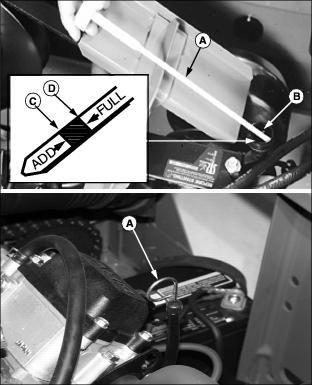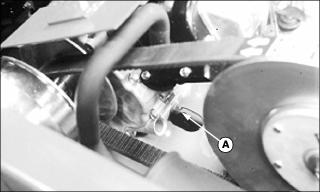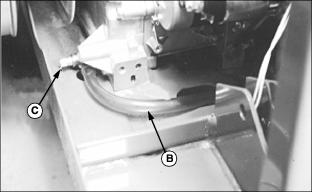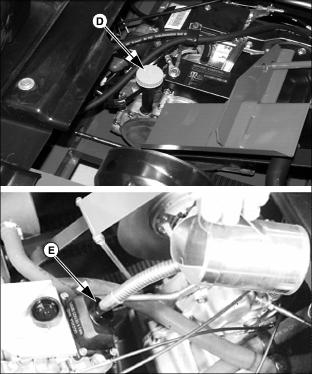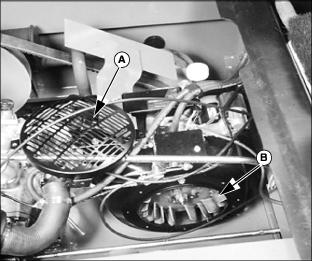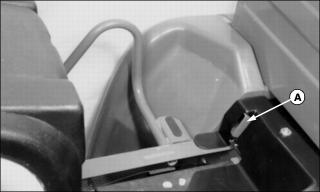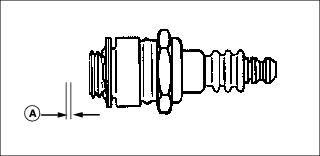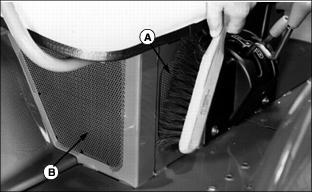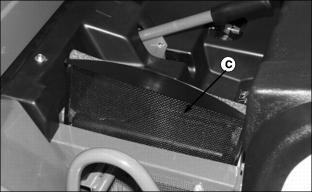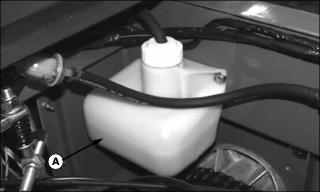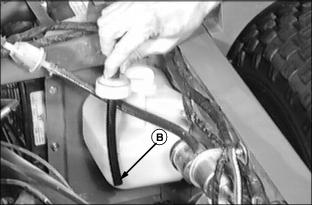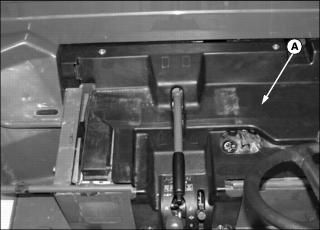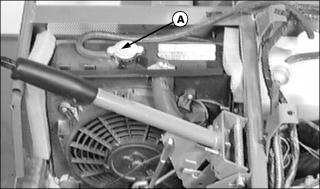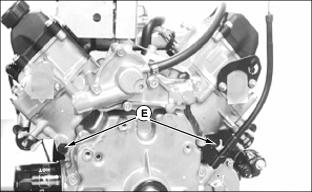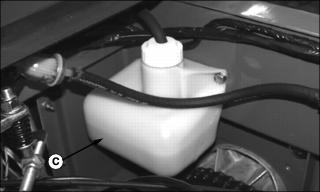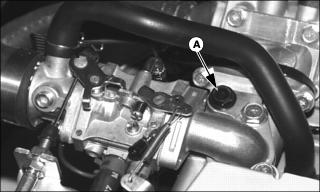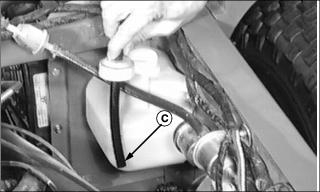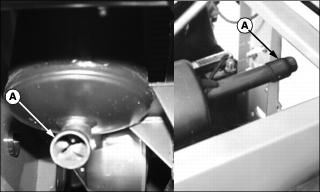Introduction
Product Identification
Safety
Operating
Replacement Parts
Service Intervals
Service Lubrication
Service Engine
Engine Warranty Maintenance Statement
Changing Engine Oil and Filter
Cleaning Rubber Dust Unloading Valve
Cleaning Engine Cooling Screens
Servicing Cooling System (6x4)
Service Transmission
Service Electrical
Service Miscellaneous
Troubleshooting
Storage
Assembly
Specifications
Warranty
John Deere Quality Statement
Service Record
Copyright© Deere & Company

Service Engine
Engine Warranty Maintenance Statement
Maintenance, repair, or replacement of the emission control devices and systems on this engine, which are being done at the customers expense, may be performed by any non-road engine repair establishment or individual. Warranty repairs must be performed by an authorized John Deere dealer.
Avoid Fumes
Engine Oil
Use oil viscosity based on the expected air temperature range during the period between oil changes.
The following John Deere oils are preferred:
Other oils may be used if above John Deere oils are not available, provided they meet the following specification:
· API Service Classification SG or higher
Checking Engine Oil Level
1. Park the vehicle safely. (See Parking Safely in the SAFETY section.)
2. Raise and secure cargo box.
Picture Note: GATOR 4x2 shown upper, 6x4 shown lower.
3. Remove dipstick (A) and wipe it clean.
· GATOR 4x2 - Insert dipstick into filler tube and rest threads of dipstick cap on top of filler tube neck (B).
· GATOR 6x4 - Insert dipstick fully into dipstick tube.
· Oil level must be between marks (C) and (D) on dipstick.
· If oil level is low, add oil to bring oil level no higher than upper mark (D) on dipstick.
· If oil level is above upper mark (D), drain to proper level. Determine cause of this condition and correct.
Changing Engine Oil and Filter
IMPORTANT: Avoid damage! Change the oil more often if the vehicle is used in extreme conditions: |
1. Run engine to warm the oil.
2. Park the vehicle safely. (See Parking Safely in the SAFETY section.)
3. Raise and secure cargo box.
4. Place drain pan under engine.
· GATOR 4x2 - remove drain plug (A) at rear of engine to drain oil.
· GATOR 6x4 - Route drain tube (B) through hole in floor plate and turn petcock valve (C) to drain oil.
NOTE: Engine oil filter is optional on GATOR 4x2.
6. Remove and discard oil filter. Wipe off filter base on engine.
7. Put a light coat of clean engine oil on gasket of new oil filter.
8. Install new filter by turning it to the right (clockwise) until rubber gasket contacts filter base. Tighten filter an additional one-half turn.
9. Install drain plug (4x2) or close drain petcock and remove hose from drain hole in floor plate (6x4).
· GATOR 4x2 - Unscrew dipstick (D) from filler tube.
· GATOR 6x4 - Pull off oil fill cap from filler opening (E).
IMPORTANT: Avoid damage! Do not overfill crankcase with oil. Oil capacities given are with engine and crankcase completely dry. Some oil will remain in engine after draining. |
· GATOR 4x2 (without optional filter) - 1.1 L (1.16 qt).
· GATOR 4x2 (with optional filter) - 1.3 L (1.37 qt).
· GATOR 6x4 - 1.3 L (1.37 qt).
13. Install dipstick (4x2) or oil fill cap (6x4).
14. Start engine and check for leaks.
16. Check engine oil level again.
Cleaning Rubber Dust Unloading Valve
IMPORTANT: Avoid damage! DO NOT operate engine without air cleaner element and rubber dust unloading valve installed. |
1. Park the vehicle safely. (See Parking Safely in the SAFETY section.)
2. Locate dust unloading valve:
· GATOR 4x2 - Raise and secure cargo box.
· GATOR 6x4 - Access through opening at rear of vehicle.
3. Visually check dust unloading valve (A). Replace with new valve if worn, damaged, or missing.
4. GATOR 4x2 - Lower cargo box.
Cleaning Engine Fins (4x2)
· Clear work area of bystanders. · Wear eye protection when using compressed air for cleaning purposes. |
1. Park vehicle safely. (See Parking Safely in the SAFETY section.)
2. Raise and secure cargo box.
3. Disconnect spark plug wire.
4. Remove four cap screws from shroud (A).
5. Use a brush or compressed air to clean fins (B).
Servicing Air Cleaner Element
1. Park the vehicle safely. (See Parking Safely in the SAFETY section.)
3. Raise and secure cargo box.
Picture Note: GATOR 4x2 shown upper, 6x4 shown lower.
4. Release latches (A) and remove air cleaner canister cover (B).
5. Remove and discard filter element (C). Replace with a new filter element.
6. Install air cleaner canister cover with rubber dust unloading valve pointing downward. Check instruction molded into canister cover for proper installation.
7. Hook the canister cover latches.
Checking Air Intake
1. Park the vehicle safely. (See Parking Safely in the SAFETY section.)
2. Tip passenger seat forward.
3. Make sure air intake tube (A) is free from obstructions. Clean if necessary.
Checking Spark Plug
1. Park the vehicle safely. (See Parking Safely in the SAFETY section.)
2. Raise and secure cargo box.
3. Disconnect spark plug wire(s).
4. Remove spark plug(s) using appropriate spark plug socket.
· Pitted or damaged electrodes.
6. Clean spark plug carefully with a wire brush.
NOTE: In Canada, replace with resistor spark plug only.
7. Replace spark plug(s) if necessary.
8. Check and adjust spark plug gap (A):
9. Install and tighten spark plug(s). Tighten to 20 N·m (15 lb-ft.).
10. Install spark plug wire(s).
Replacing Fuel Filter
1. Park the vehicle safely. (See Parking Safely in the SAFETY section.)
2. Raise and secure cargo box.
Picture Note: GATOR 4x2 shown top, 6x4 shown bottom.
3. Locate the fuel filter (A) at the front of the engine compartment.
4. Check element of fuel filter for debris. Replace if dirt or sediment is visible on element.
5. Slide hose clamps away from the fuel filter.
6. Place a drain pan or cloth under hoses to catch any fuel that may be left in hoses.
7. Disconnect hoses from the filter.
NOTE: Make sure fuel filter is installed with arrow pointing in direction of fuel flow toward engine.
9. Connect hoses to new filter.
Adjusting Carburetor
NOTE: Carburetor is calibrated by the engine manufacturer and is not adjustable.
If engine is operated at altitudes above 1829 m (6,000 ft), some carburetors may require a special high altitude main jet. See your John Deere dealer.
If engine is hard to start or runs rough, check the troubleshooting section of this manual.
After performing the checks in the troubleshooting section and your engine is still not performing correctly, contact your John Deere dealer.
Cleaning Engine Compartment
1. Park the vehicle safely. (See Parking Safely in the SAFETY section.)
2. Raise and secure cargo box.
IMPORTANT: Avoid damage! Do not spray water on a hot engine or transaxle. Damage may occur to cast aluminum parts. Allow engine to cool before servicing. |
3. Remove any debris in engine compartment.
4. Check and remove any obstructions to brake linkage attached to output shafts on both sides of transaxle.
Cleaning Engine Cooling Screens
· Clear work area of bystanders. · Wear eye protection when using compressed air for cleaning purposes. |
The vehicle requires large volumes of air to keep cool. Keep engine compartment clean. Be sure fan or flywheel screens remain installed and clean.
1. Clean front screen (A) with rag, brush, or compressed air.
IMPORTANT: Avoid damage! Side screen must be removed for cleaning to avoid contaminating or damaging the radiator. |
2. 6x4 Only - Remove and clean side screen (B). Install side screen after cleaning.
3. Tip passenger seat forward.
4. Pull up to remove radiator screen (C). Clean screen.
Recommended Engine Coolant
The following John Deere coolants are preferred:
· COOL-GARD PRE-DILUTED SUMMER COOLANT (TY16036).
· COOL-GARD CONCENTRATED SUMMER COOLANT (TY16034).
If neither of the recommended coolants is available, use a glycol base coolant that meets the following specification:
Check container label before using to be sure it has the appropriate specifications for your machine. Use coolant with conditioner or add conditioner to coolant before using.
If using concentrate, mix approximately 50 percent antifreeze with 50 percent distilled or deionized water before adding to cooling system. This mixture will provide freeze protection to -37 degrees C (-34 degrees F).
Certain geographical areas may require lower temperature protection. See the label on your antifreeze container or consult your John Deere dealer to obtain the latest information and recommendations.
Checking Coolant Level (6x4)
1. Park the vehicle safely. (See Parking Safely in the SAFETY section.)
3. Raise and secure cargo box.
4. Check coolant level in overflow reservoir (A):
· If engine is warm, reservoir tank should contain 75-100 mm (3 - 4 in.) of coolant.
· If engine is cold, reservoir tank should contain approximately 25 - 50 mm (1 - 2 in.) of coolant.
5. Remove recovery tank cap if necessary to add coolant.
6. Add coolant mixture to reservoir tank.
IMPORTANT: Avoid damage! Coolant cannot be drawn into cooling system if suction hose is installed wrong. Do not allow bottom of hose (B) to touch bottom of bottle or bend upwards out of coolant. |
7. Install and tighten recovery tank cap.
Servicing Cooling System (6x4)
IMPORTANT: Avoid damage! Follow all service procedures exactly. If not equipped to perform this work, see your John Deere dealer for service. |
Prepare Vehicle
1. Park the vehicle safely. (See Parking Safely in the SAFETY section.)
3. Pull off the differential lock lever knob. Unscrew the transaxle shift lever knob.
4. Remove seat base panel (A) from vehicle.
Draining Cooling System
NOTE: Cooling system capacity is approximately 4.3 L (4.5 qt), including reservoir.
1. Make sure engine has cooled completely.
2. Slowly open radiator cap (A) to the first stop to release all pressure.
3. Remove cap after all pressure is released.
4. Remove hardware (B) securing the radiator.
NOTE: If radiator drain plug is seized, lower radiator hose can be removed for draining purposes.
5. Lift radiator slightly to access drain plug (C). Remove radiator drain plug or disconnect lower radiator hose (D). Allow coolant to drain into a container.
NOTE: Engine block drain screws may be black in color.
6. Loosen engine block drain screws (E) on right side of engine. Allow coolant to drain into a container.
7. After all coolant has drained, install radiator plug or connect radiator hose and tighten the engine block drain screws.
8. Check condition of all hoses. Replace as needed. Check all hose clamps and tighten as needed.
Flushing Cooling System
1. Prepare a cooling system flushing solution using clean water and John Deere Cooling System Cleaner, John Deere Cooling System Quick Flush, or an equivalent.
2. Fill radiator completely with flushing solution. Install and tighten radiator cap.
3. Start and run engine until it reaches operating temperature.
5. Turn radiator cap slowly to the stop to release system pressure. Remove radiator cap.
6. Drain cooling system immediately into a container before rust and dirt settle:
· Remove radiator drain plug or the lower radiator hose.
· Loosen engine block drain screws.
7. After all solution has drained, install radiator drain plug or hose and tighten engine block drain screws.
8. Push radiator back into place and secure with original hardware.
9. Install seat base panel and seats.
10. Remove and clean overflow reservoir (C).
Filling and Bleeding Cooling System
NOTE: John Deere COOL-GARD coolant is recommended when adding coolant to the cooling system. Follow the directions on the container for correct mixture ratio.
Cooling system capacity is approximately 4.3L (4.5 qt.) including reservoir.
1. Allow engine to cool completely.
NOTE: Engine block bleed screw may be black in color.
2. Remove bleed screw and seal washer (A) located by carburetor.
3. Add recommended coolant mixture to radiator until it runs out of radiator cap hole. Install and tighten radiator cap.
IMPORTANT: Avoid damage! Bleed screw uses a special aluminum seal washer. Do not lose or substitute with any other type of washer. |
4. Add coolant mixture at bleed screw port (B) until coolant runs out. Tighten bleed screw with washer halfway into bleed port.
5. Add coolant mixture to reservoir so it is approximately half full.
6. Install overflow cap and hose.
IMPORTANT: Avoid damage! If coolant temperature indicator comes on while engine is running, stop engine and add more coolant mixture to radiator. |
8. Start and run engine at medium speed until upper and lower radiator hoses have become warm (10 - 15 minutes), indicating thermostat has opened and coolant is circulating.
9. Add coolant to radiator until air bubbles are no longer visible at bleed port. Tighten bleed screw completely and install and tighten radiator cap.
10. Continue running engine until cooling fan starts, indicating the engine and coolant has reached operating temperature.
11. Stop engine and remove key.
12. Allow engine to cool and suction back any needed coolant from overflow reservoir. Fill reservoir as needed so it contains 25 - 50 mm (1 -2 in.) of coolant.
Checking Spark Arrestor
1. Park the vehicle safely. (See Parking Safely in the SAFETY section.)
2. Allow vehicle to cool completely.
Picture Note: GATOR 4x2 shown left, 6x4 shown right.
3. Remove screw securing spark arrestor (A) to muffler exhaust pipe. Retain the screw.
5. Make sure deflector screen inside arrestor is not plugged or damaged:
· If plugged, spray with carburetor/choke cleaner and blow dry with low pressure compressed air.


